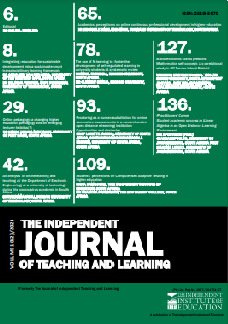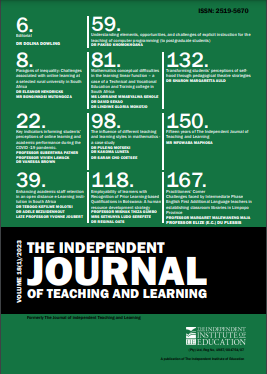Archives
-

The Independent Journal of Teaching and Learning
Vol. 19 No. 1 (2024)The digital revolution is advancing at an unprecedented pace. Large language models (LLMs) like ChatGPT, Gemini, and others are progressing exponentially. The tantalizing prospect of Artificial Intelligence (AI) becoming a major contributor to the global public good draws ever closer. Its expected capabilities mean that most, if not all, aspects of human life stand to benefit. Currently, AI is successfully used in the diagnosis of illness from medical imaging, the provision of personalised medicine using genetics and medical history, and AI-assisted robotic surgery. Such capabilities are not confined to healthcare, significant strides are being made which will enhance all aspects of human life. However, for everyone to benefit, the ever-widening digital divide between the global north and global south demands urgent attention, as highlighted in earlier editorials of this journal.
When we turn to education, AI is transforming the education landscape. Whilst we are still in the early stage of disruption, technology adoption across all education sectors is increasing albeit at varying levels of complexity. In the school sector, AI is having a positive impact by enhancing teaching and learning experiences and learning materials being tailored to meet individual needs which promotes student success. For example, online learning platforms like the US-founded Carnegie Learning MATHia and the Oak National Academy funded by the Department of Education in England are gaining momentum. Higher education institutions (HEIs) are also increasingly embracing technology. Positive and innovative technologically-driven learning interactions abound. Despite their use and integration in all aspects of their operations, the human element is still key as social intelligence, empathy and creativity are attributes that AI cannot replicate. Human expertise is needed to harness AI effectively and yield the precise algorithms to meet the desired outputs.
In this first edition of the 19th volume of the journal, the use of technology in delivering a high-quality learning experience fit for the 21st century is clear as seen in the first cluster of four articles. In the first, the authors explore Collaborative Online International Learning (COIL) using a concurrent nested mixed methods research approach. Challenges identified include lecturer capability and preparedness, and the practicality of working across widely different time zones. In the second article, the authors address the impact of the COVID-19 pandemic with its concomitant move to online teaching, learning and assessment. The study shows that performance management systems need to be realigned as HEIs transition to university 4.0 with its focus on personalized learning, dynamic pathways, and student-centred education. In the following article, training of tutors within university tutoring programmes is explored.
Given the identified positive effects of such training, HEIs need to invest in tutor training. The fourth article uses a qualitative study to explore the challenges arising from online student collaborations at an Open Distance Learning university. The author presents guidelines for enhancement and mitigation.
The next four articles deal with an array of issues both in schools and higher education. The first highlights the challenges of source-code plagiarism detection in coding assessments. This was exacerbated during the COVID-19 pandemic due to the introduction of online assessments. The authors use qualitative and quantitative data to refine the process of source-code plagiarism detection. The following article investigates how adopting a Social-Emotional Learning (SEL) approach to leadership influenced the learning culture in low-decile Limpopo, South African schools during the COVID-19 pandemic. The researchers found that SEL fosters mindfulness, self-mastery, effective communication, and relationshipbuilding skills. They recommend providing SEL training for school leaders and integrating SEL into teacher training programmes. The third article provides a narrative approach to explore the hidden curriculum in classrooms within private higher education. The findings contribute to an understanding of how lecturers perceive and engage with the hidden curriculum. The last article in this cluster investigates a medical condition, Dyscalculia, which affects learners’ comprehension and manipulation of numerical concepts. This has a negative impact on academic performance in mathematics. Recognizing this condition is crucial so that mechanisms can be implemented to support such learners.
In Practitioners’ Corner the problem of increased child sexual abuse in Zimbabwe along with parent resistance to the use of comprehensive sexuality education (CSE) is explored. This resistance is due to cultural and religious beliefs. The authors’ research shows that advocacy campaigns and communication with parents on what CSE entails is essential in gaining parental support.








.png)